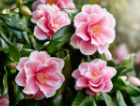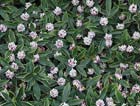
"No winter lasts forever; no spring skips its turn." – Hal Borland
Winter is coming! This means we will experience about 8 hours of sunlight each day, leaving us with 16 hours of darkness. As we watch the leaves fall, our plants enter dormancy, becoming bare and lifeless. We long for color, fragrance, and signs of thriving life. Are there any plants that can bring color and scent to our winters?
Fortunately, we live in a region rich with evergreens and plants that add vibrancy to the winter landscape. Here are a few of our favorites:
Click to enlarge.

Camellia sasanqua is a stunning choice for winter gardens, bringing a splash of color during the cold months when most plants lie dormant. It boasts glossy, dark green evergreen foliage that remains vibrant throughout the year, providing a lush backdrop for its exquisite blooms. The flowers, varying in hue from delicate white to soft pale pink, are mildly fragrant and stand out with their bright yellow stamens. These mesmerizing blossoms can grace your garden from fall through winter, creating a warm and inviting atmosphere despite the chill of the season.
Why it's one of our favorites.
- Winter blooms
- Long-lasting flowers
- Evergreen, shiny, deep green leaves
- Hardiness that is resistant to root rot
- Low maintenance

Helleborus 'Anna's Red' adds a dramatic touch to winter landscapes with its striking deep red flowers. These captivating blooms emerge during the dormant season, contrasting beautifully with the plant’s lush, evergreen leaves to ensure year-round visual interest. This compact, low-maintenance perennial is perfect for busy gardeners and is known for its resilience against deer. Additionally, it attracts pollinators, making it a wonderful choice for environmentally friendly gardens. Whether planted in pots, as borders, or in shaded areas, 'Anna's Red' enhances any winter garden with both its beauty and practicality.
Why it's one of our favorites.
- Winter color with deep red flowers late winter to early spring/li>
- Evergreen, silvery-veined foliage
- Pest-resistant, deer, and rabbits
- Low maintenance, long-lived, drought-tolerant, easy to grow
- Attracts pollinators
- Versatile for small spaces
- Good for cut flowers

Dan Hinkley, one of my horticulture professors, would say, “Everyone needs a Daphne in their yard.” I wholeheartedly agree. These broadleaf evergreen shrubs are densely branched with glossy green leaves edged with a band of yellow or white. One remarkable benefit is that they have a sweet scent in mid-winter that turns intensely fragrant in February and March when their reddish-purple flower with creamy pink throats bloom.
Why it's one of our favorites.
- Evergreen
- Remarkable mid-winter scent
- Easy maintenance
- Grows to 3 to 4 feet in height and spread
- Sun, but best in partial shade
- Adaptable to many soil types but needs good drainage
- Native to Japan and China

This low, tight evergreen shrub may also be used as a ground cover. Shade-loving shrubs are difficult to find in the Northwest. Sweetbox is one that thrives in full shade. It’s leathery leaves offer a rich carpet of deep green. Tiny, nondescript white flowers bloom in mid-winter to early spring and blue-black berries appear in summer. Humilis, the low growing variety, grows to only 1-2 feet tall and spreads to 4 feet when mature.
Why it's one of our favorites.
- Evergreen, low, tight ground cover which behaves itself
- Shears easily and does not take over like some ground covers
- Has a lightly permeating scent when it flowers in mid-winter to early spring
- Deer and rabbit resistant

Though Beautyberry (var. profusion), a deciduous shrub, looses it’s leaves in fall, it is known for its showy, bright purple berries which mature in fall and remain well into winter. It’s a hearty plant that is easy to prune and can even be sheared. Lilac flowers in dense sprays bloom in summer and are best if in full sun. Leaves emerge bronze-purple in spring, turn to dark green in summer and finally turn to golden-purple in fall. These shifting colors bring a unique personality to Beautyberry all year long.
Why it's one of our favorites.
- Provides a very unique winter splash of bright purple berries
- Easy to prune, even sheared
- Hearty Northwest plant that prefers full sun but can tolerate some shade
- Changing leaf color, summer flowers and bright purple berries in winter
- Grows to 4 to 6 feet in height and spread

This winter-blooming deciduous shrub has paper mâche like red to copper-red flowers that are mildly fragrant. It’s vase-like formation fits in with urban settings and can double as a large shrub or small tree. Broad green leaves turn attractive shades of yellow, orange and red in fall with flowers appearing in mid-to-late winter before spring leaves begin to sprout.
Why it's one of our favorites.
- Copper-red flowers bring color in winter
- Deer resistant
- Slow growth makes it easy to maintain
- Can double as a shrub or small tree with 8 to 12 foot height with 10 to 15 foot spread when mature
- Gets better with age and is resistant to disease

For color in winter, this is a winner. When covered with magenta flowers from mid-winter to mid-spring it will brighten any gloomy winter day. It is a vigorous shrub that requires little care and is virtually disease and pest free. Perfect for smothering weeds and grows well on slopes. It is best in full sun in sandy, acidic, well-drained soils, but has done well on north facing slopes with ample summer sun but no winter sun. Newly planted Heath can dry quickly, so water regularly when the plant is young. Annual light shearing promotes a bushier plant and occasionally removing a branch from the inside will promote inner growth.
Why it's one of our favorites.
- Can bloom up to six months from mid-winter to mid-spring
- Plant in groups for the most dramatic color impact
- One of the less woody heaths
- Prefers full sun (especially in summer months)
- Grows to 18 inches tall with 2 foot spread

Though the Bloodtwig Dogwood is a deciduous shrub, it brings truly stunning winter color with it’s yellow winter stems tipped with bright red twigs. Fire is an appropriate description because it can literally look look like fire bursting from the earth. It is attractive year-round with medium green leaves, tiny white flowers in late spring, dark purple berries in summer, golden yellow foliage in summer and then stunning yellow to crimson branches and stems in winter.
Why it's one of our favorites.
- Truly stunning winter color
- Seasonal color shifts of leaves, flowers, berries and stems
- Multi-stemmed shrub growing 5 to 6 feet tall and wide
- Easy to grow and care for, pest and deer tolerant
After 30+ years of landscaping, these plants, year-in and year-out, have been my top picks for the winter season. They bring color, scent and life to what can be a gloomy season.
If you have any plant questions, drop me an email at
Jim Reynolds
Owner & Founder
To learn more about these and other plants we recommend the following websites.
Gardenia.net
Missouri Botanical Garden.org
Greatplantpicks.org

